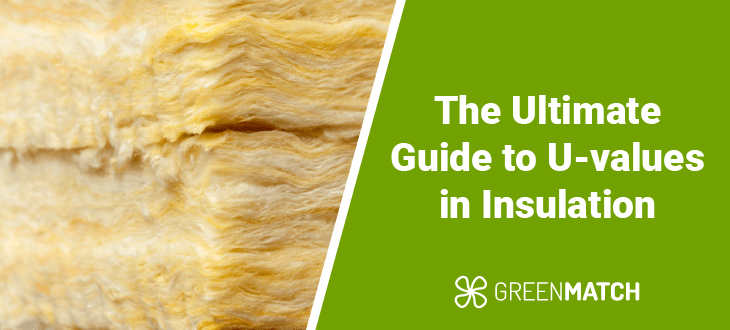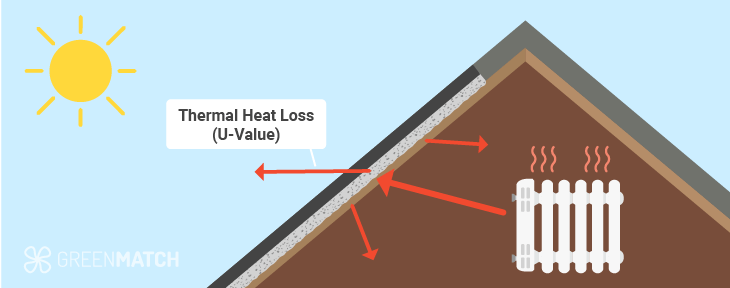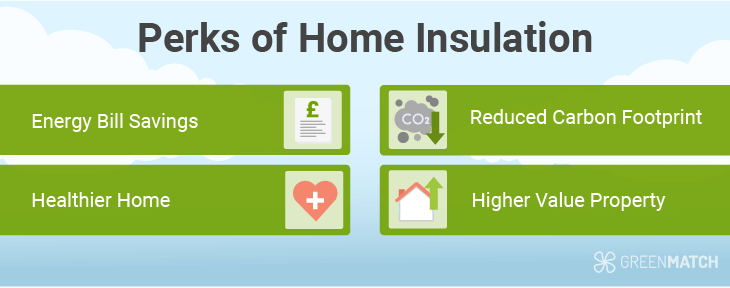Answer these simple questions and we will find you the BEST prices
Which type of solar quotes do you need?
It only takes 30 seconds
100% free with no obligation

Get Free quotes from insulation specialists near you

Save money by comparing quotes and choosing the most competitive offer

The service is 100% free and with no obligation
- GreenMatch
- Insulation
- U-Value Insulation
U-Value Insulation: How Does It Work?
→ Macro "Author Byline" will be inserted here ←

- U-value measures the rate of effectiveness of a material in preventing heat transfer. In other words, the U-value shows how good a material is at insulating.
- The lower the u-value, the better insulation it provides. For example, a U-value of at least 0.18 W/m2K is expected for cavity wall insulation.
- Choosing materials with a high U-value performance can improve the U-value of your home insulation. Some good examples are insulation boards such as PIR and cork.
Have you ever wondered; what is a U-value in insulation? Simply put, the U-value of a material shows us the rate of how effective a material is at resisting heat transfer. Also called thermal transmittance, the value assigned to a material shows the heat transfer rate. This means that the lower the U-value, the better it resists heat transfer.
With the UK’s ambitious goal of reaching Net Zero by 2050, the thermal efficiency of home insulation has become a very important focus. This ultimate guide by GreenMatch UK is here to break down everything important you need to know about insulation U-value, what is a good value, how to calculate it, and how to improve it.
Ready to insulate your home? Let GreenMatch UK be your one-stop solution for all your needs. Simply spend 30 seconds filling out our online form and receive up to 3 free home-tailored quotes straight from our network of professional installers. No charges or obligations. Click the button below to begin!
- Describe your needs
- Get free quotes
- Choose the best offer
It only takes 30 seconds



What is the U-value in insulation?

The U-value of insulation indicates the rate at how good a material is resisting the transfer of heat. Therefore, a lower insulation U-value means it takes longer for heat to transfer through. Your chosen insulation material should have low U-value insulation, ensuring that your home will be thermally enveloped.
The U-value in insulation should not be confused with the R-value. While the U-value shows us the rate of heat transfer, the R-value is considered to be the inverse, which shows us how good a material is at resisting heat transfer.
While in theory, all materials have a U-value and R-value, this only matters when speaking about thermal insulation. On the other hand, acoustic insulation is manufactured to absorb and reflect sound waves, not heat. Therefore, the U-value is irrelevant.
Some thermal acoustic insulation materials exhibit capacity in both avenues, such as mineral wool, cotton, and sheep wool.
What is a good U-value for insulation?
There is no best U-value for insulation, but most effective materials will have a U-value somewhere in the range of 0.04 - 0.01 W/m2K, with more effective materials closer to 0.01.
For example, mineral wool has a U-value range of 0.030 - 0.040 W/m2K, whereas PIR insulation boards have a more impressive 0.022 - 0.028 W/m2K, making them better thermal insulators.
Also, the expected U-value for loft insulation will differ from that U-value for insulation of other home areas such as walls and floors.
How do you calculate the U-value for insulation?
The formula for calculating the U-value of a material is U = 1/(Sum of all R-value).
In comparison, the R-value of a material is considered to be the opposite of the U-value. So if you were to calculate the R-value, you would use the formula R = 1/(Sum of all U-values). They are inverses of each other. Sounding a bit confusing? Let’s try to break it down.
While the U-value tells us the rate of how good a material is at resisting heat transfer, the R-value shows us the inverse of how good a material is at resisting heat transfer. Being the flipped version, this means a higher R-value means a material is better at resisting heat.
Still confused? Don’t worry if it doesn’t make sense. It’s most important to understand what these values represent when you are on the market for effective insulation materials. Keep an eye out for low U-values and high R-values for the most effective insulation.
U-value insulation regulations
Current building regulations in the UK have been updated since 2022, and outline a series of expectations, including the thermal efficiency of insulation materials exemplified through the minimum expected U-values, highlighted in The Approved Documents L (ADL).
These insulation regulations outline the specific thermal efficiency expectations, for example regarding cavity wall insulation U-value, and exist to make sure that insulation measures around the UK are living up to standards expected to achieve the nationwide Net Zero target by 2050.
As of current, the expected minimum U-values for various insulation measures are as follows:
| Insulation job | Type | Expected U-value |
|---|---|---|
| Roofs | New build | 0.11 W/m²K |
| Walls | New build | 0.18 W/m²K |
| Floors | New build | 0.13 W/m²K |
| Roofs | Renovation | 0.15 W/m²K |
| Walls | Renovation | 0.18 W/m²K |
| Floors | Renovation | 0.18 W/m²K |
| Roofs | Existing element | 0.16 W/m²K |
| Walls | Existing element | 0.30 W/m²K |
| Floor | Existing element | 0.25 W/m²K |
New builds are properties that are being built from scratch and tend to have stricter U-value expectations in place as a result. This is because it's more possible to bring up a newly built property to efficient standards than an old one.
The expected U-values for older property renovations and upgrading of existing elements are far more lenient, as they take into account the challenges and complexities that come with retrofitting older properties.
The cost of insulation can also differ based on whether you are a new building or an existing property. This is especially the case if you have outdated and inefficient insulation in place that still needs removal. Still, insulation grants exist to help qualifying households with fronting the investment needed for proper home insulation.
Ready to insulate your home? Let GreenMatch UK free you from burdensome hours of researching and vetting installers. Instead of spending the time stuck on websites and phone calls, spend just 30 seconds filling out our simple online form and get up to 3 free home-tailored quotes from professionals in your area free of charge. Click the button below to begin!
- Describe your needs
- Get free quotes
- Choose the best offer
It only takes 30 seconds



How to improve the U-value of your insulation
The best way to improve the U-value of your home insulation is to simply use insulation materials with lower U-values. There’s very little you can do to existing insulation, however, if it is in good condition, then perhaps it can be topped up to a larger thickness.
For example, for an acceptable loft insulation U-value, materials such as mineral wool should be expanded to a thickness of at least 270mm to achieve the expectations set by UK regulations.
Is insulation the right choice for my house?

With all things considered, effective house insulation is an upgrade with a wealth of benefits for your home comfort, savings, environmental standing, and even property value.
Here are just a few of the key benefits you could enjoy:
- Energy bill savings: Proper home insulation can bring sky-high savings to your home. This is because your heating system will no longer need to work constantly to make up for lost heat. A combination of wall, floor and loft insulation in a detached UK home can save you a staggering £1,020 every year.
- Healthier home: A well-insulated home also has fewer condensation problems, reducing the risk of mould, mildew and structural rot. Not only does this keep your home safer, but also promotes a healthier immune system and less risk of respiratory illnesses.
- Reduced carbon footprint: According to The Guardian, the UK’s housing stock is responsible for a shocking 14% of the nation's total CO2 emissions. With proper insulation, your heating system works less, reducing your carbon footprint overall. A combination of floor, loft, and wall insulation in a detached UK home can cut your carbon emissions by up to 2.4 tonnes every year.
- Higher value property: Homes that are better insulated will be valued higher in the housing market, should you decide to sell or rent it out. This is because prospective clients know that insulated houses are more comfortable, have lower energy bills, and are more sustainable to live in, making them more attractive on the market.
Ready to insulate your home? We’re glad! The next step will be finding the right installer at the right bargain. Many homeowners often get stuck spending endless hours researching and vetting installers with no choices in sight. Luckily, GreenMatch UK can free you from the burden.
By filling out our simple 30-second online form, you can receive up to 3 free home-tailored quotes directly from our network of pre-vetted professionals. The best part? Our services are completely free of charges and obligations. Click the button below to begin!
- Describe your needs
- Get free quotes
- Choose the best offer
It only takes 30 seconds



FAQ
The U-value of insulation materials varies depending on the material you opt for, and the thickness of material you install. Generally speaking, most market insulation materials will be within the U-value range of 0.04 – 0.01 W/m2K, with more effective materials closer to 0.01.
The U-value of 100mm of insulation material will depend more on the material you have chosen. For example, if you were to have chosen PIR insulation, 100mm would grant you a U-value of around 0.25 W/m2K. However, the recommended insulation thickness for PIR insulation is 125mm, which would help achieve a U-value of around 0.17 W/m2K.
As the U-value shows the rate of heat transfer, a lower U-value is better. The lower the number, the slower the rate of heat transfer through a material.
The U-value expectation for walls in the UK differs depending on whether your property is a new build, being renovated, or an extension of an existing property. For renovation properties, which is the case for most homes in the UK, the expected U-value for walls is 0.18 W/m²K.
The best U-value of loft insulation to be achieved is 0.15 W/m²K for renovation properties. For a completely new built home, it’s expected to achieve a U-value of around 0.11 W/m²K.
The U-value needed for your property is outlined in The Approved Documents L (ADL) of the UK Building Regulations. New builds, renovations, and existing elements each have different U-value expectations in place. For renovations, walls and floors should be 0.18 W/m²K, and roofs/lofts should be 0.15 W/m²K.

Akif is a copywriter at GreenMatch since 2023. With a keen interest in community sustainability, green solutions and the role of digital media in identifying climate trends, he aims to hone in on his background in International Studies and Digital Media to provide a multidisciplinary approach to written content rooted in credible research and accuracy.
We strive to connect our customers with the right product and supplier. Would you like to be part of GreenMatch?

